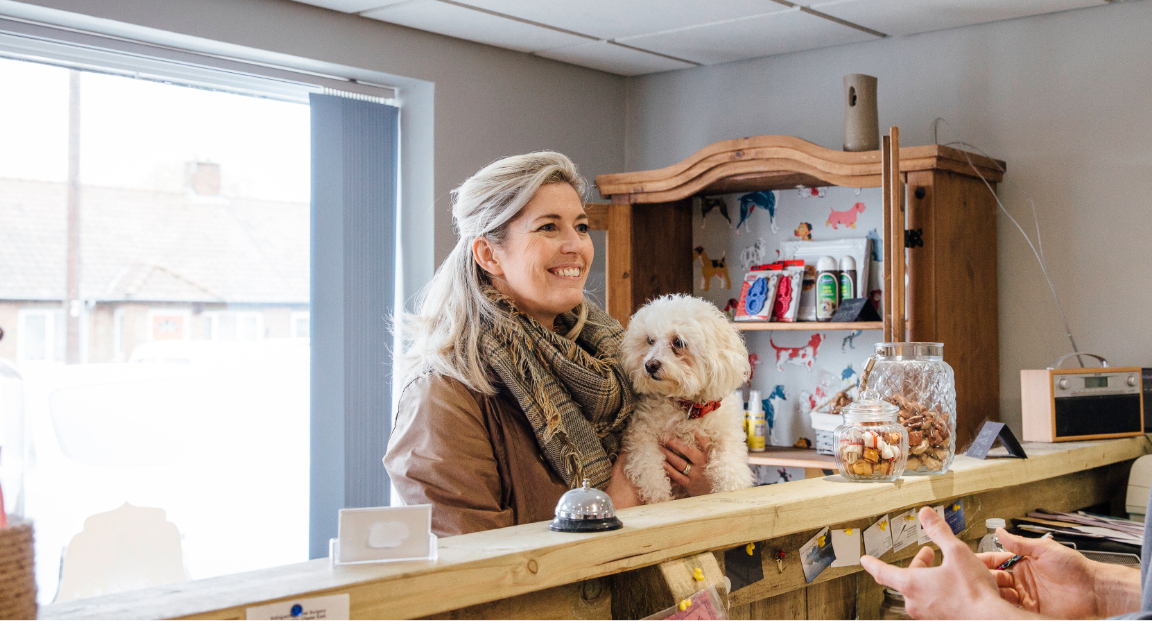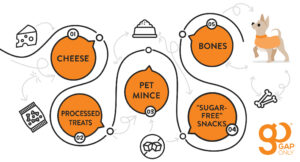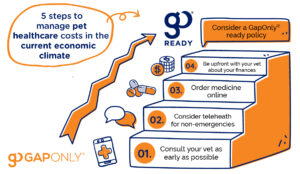Pet healthcare costs: can you afford it?
With current cost-of-living pressures, understanding and preparing for pet ownership expenses is important. Beyond the initial outlay of buying or adopting a pet, there are ongoing expenses to factor in like food, routine and unexpected veterinary care, grooming, accessories and more.
Figures from the Animal Medicines Australia “Pets in Australia” report^^ show the average household spend for a dog in 2022 was $3,218 and for a cat $1,715 – but remember, this is just costs for a year so you need to consider ongoing expenses throughout your pet’s entire life.
The below table shows common pet health ailments based on data from PetSure (the power behind GapOnly®).
| Condition | Average cost for treatment of the condition* | Highest cost for treatment of the condition* |
|---|---|---|
| Skin allergies | $520 | $17,460 |
| Ear infection | $315 | $16,670 |
| Osteoarthritis | $423 | $12,255 |
| Gastritis | $523 | $28,232 |
| Diarrhoea | $416 | $20,663 |
| Lameness | $441 | $13,634 |
| Mass Lesion – Skin (Cutaneous) | $698 | $12,012 |
| Vomiting | $565 | $26,661 |
| Anal Sac Disorder | $260 | $11,021 |
| Dental disease | $706 | $11,923 |
Disclaimer: Reimbursement for these claims would be subject to limits, such as annual benefit limits or sub-limits, benefit percentage, applicable waiting periods and any applicable excess. Cover is subject to the policy terms and conditions. You should consider the relevant Product Disclosure Statement or policy wording available from the relevant provider.
*Please note that values calculated are based on all claims for that condition and medically related conditions in each calendar year.
So, how does breed play a role in pet healthcare expenses?
While any dog breed can experience illness or accidents, some breeds may be more likely to experience certain health conditions than others. This is why it’s important to research different dog breeds to understand breed-specific health conditions, and the associated costs of veterinary care.
Most at risk dog breeds, PetSure data 2022*
- All Bulldog breeds
- Boxer
- Cavalier King Charles Spaniels
- Bernese Mountain Dog
- Great Dane
*Prevalence = Total number of unique claiming pets/total number of insured pets (trailing 12-month period). Excludes breeds with less than 500 exposed policies in the period.
Specific dog breeds like Brachycephalic breeds often experience respiratory issues, known as Brachycephalic Obstructive Airway Syndrome (BOAS). This includes popular dog breeds like French Bulldogs, Bulldogs and Pugs.
Lifestyle factors
Your living situation
Consider your living situation and the type of accommodation that will be suitable for the breed. If you live in an apartment, smaller dog breeds like Dachshunds, Pugs, and French Bulldogs may be suitable due to their smaller size and lower exercise needs.
Kid-friendly breeds
If you have kids or plan to start a family in the future, consider breeds that are child friendly. Breeds like Golden Retrievers and Labradors are known for their patient, gentle and friendly natures. It’s also a good idea to ensure your new pet spends time socialising with people of all ages, including kids from a young age.
Location and climate factors
Location and climate factors are important to consider, especially if there are extreme weather temperatures or conditions in your area. For example, some areas may be more susceptible to ticks which may increase the risk of tick paralysis for your dog.
Although any breed of dog can be affected by tick paralysis, in 2022 the top dog breeds treated for tick paralysis included the Soft Coated Wheaten Terrier, Airedale Terrier, Australian Silky Terrier and Tibetan Spaniel, which are long/wire coated breeds, according to PetSure. It may also be tricky to find ticks in dogs with longer or more curly coats, so this could be something you consider when doing your research.
Multiple pets
Adding another pet to the mix can be exciting, but just like humans sometimes personalities clash which lead to distress, injury and in some cases, surrendering pets. One way to help mitigate this is to allow your existing dog to meet the prospective new dog prior to adoption or purchasing. Many shelters will accommodate such a request, and even encourage it to help ensure a good fit.
Breed-specific factors
Exercise needs
Different dog breeds have different energy levels and exercise requirements. While some breeds, such as Bordie Colliers, Labrador Retrievers and Kelpies need plenty of exercise while others like Bulldogs or Cavalier King Charles Spaniels may not need to burn as much energy. Keep in mind too, the size of the dog isn’t always the only indicator of activity levels.
The age of the pet is also a factor to consider, with puppies and younger dogs naturally being more curious and energetic than older dogs. It’s important to match your lifestyle and activity level to a breed that suits your fitness level, to ensure you can provide your pet with enough physical exercise to maintain a healthy weight.
Breed temperament and personality
Knowing a breed’s temperament is a key part of your breed research, to ensure compatibility with your lifestyle. If you want an affectionate dog, breeds like the Cavalier King Charles Spaniel or the Shih Tzu might be a good fit. However, if you like your own space, breeds like the Basenji or the Scottish Terrier may be suitable.
Grooming needs
Long-haired breeds, like the Afghan Hound or the Maltese, often require frequent brushing and professional grooming to maintain their coat. Short-haired breeds may shed less but still need regular care.
Low shedding pets like Cavoodles have become a popular option, however not shedding is only part of the equation. Dogs that don’t shed may still need professional clipping or frequent brushing, which could come at an additional cost.
When buying or adopting a new fur baby, make sure you research different breeds so you can make an informed decision about the type of dog that will best suit your lifestyle and family.
References
^https://www.rspcasa.org.au/pet-surrenders-2018/
Animal shelters overflowing as cost-of-living pressures prompt record pet surrenders
Surrendering your pet: What you need to know
Top 8 reasons people surrendered their pets in 2018 – and what they could have done instead
Insurance products are issued by The Hollard Insurance Company Pty Ltd ABN 78 090 584 473, AFSL 241436 (Hollard) and/or PetSure (Australia) Pty Ltd ABN 95 075 949 923, AFSL 420183 (PetSure) (from 8 May 2023 only), administered by PetSure and promoted and distributed through their authorised representatives and distribution partners.
Any advice provided is general only and does not take into account your individual objectives, financial situation or needs. Cover is subject to the policy terms and conditions. Please consider the Product Disclosure Statement (PDS) to ensure this product meets your needs before purchasing or choosing to continue with the product. PDS and Target Market Determination available on our partners’ websites. Meet our partners at petsure.com.au/partners.








